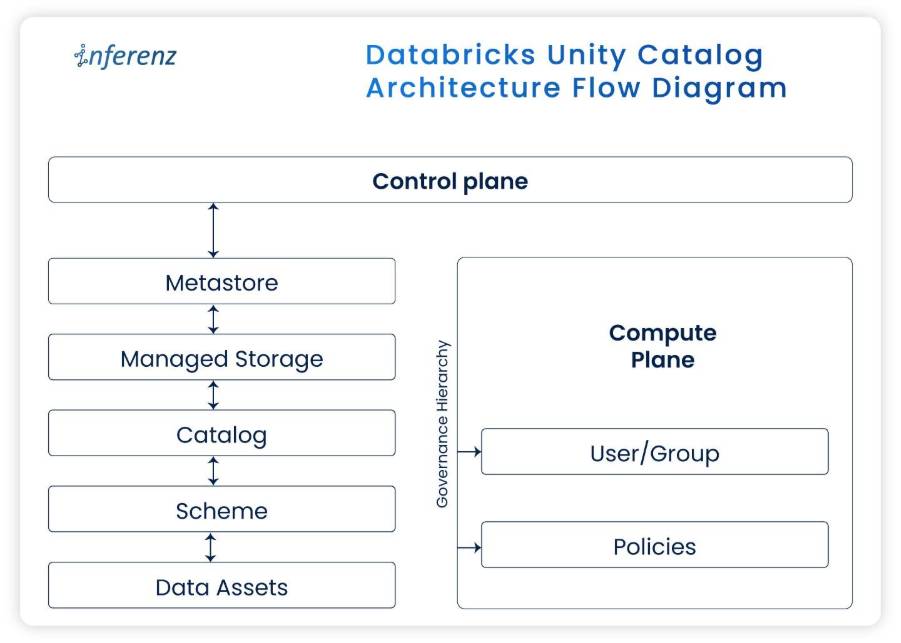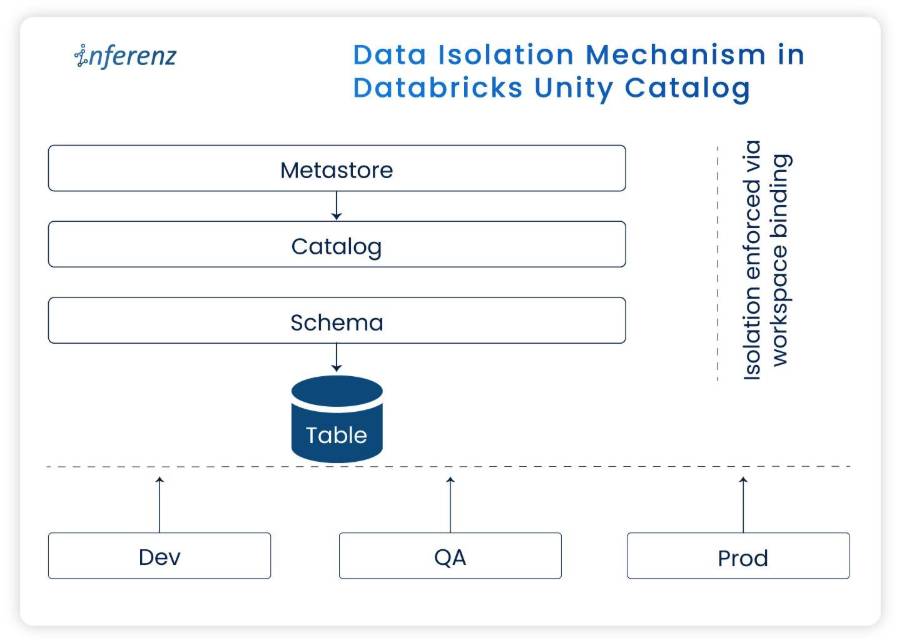Background summary
Modern healthcare and homecare organizations are struggling with scattered data, compliance pressure, and rising operational costs. A unified governance framework like Databricks Unity Catalog helps CIOs secure PHI, enforce HIPAA-ready controls, and streamline analytics across teams. By centralizing access, metadata, and lineage, it transforms the healthcare data platform into a scalable, trusted foundation for care delivery.
Modern healthcare systems are rich with data but often poor in data governance. From patient records and billing data to IoT streams and clinical notes, information is scattered across teams, tools, and cloud environments. This fragmentation increases compliance risks, slows down analytics, and creates operational bottlenecks.
Databricks Unity Catalog changes that. As a modern data governance solution built for platforms like Databricks, it provides centralized access control, audit trails, metadata management, and fine-grained lineage—all critical for healthcare CIOs navigating HIPAA, payer audits, and workforce scaling.
In this article, we share how Inferenz, a data-to-AI solutions provider, rolled out Unity Catalog across its Azure-based lakehouse environments. You’ll find architectural insights and real-world production lessons to align governance with clinical and operational goals.
Problem statement
Before adopting Unity Catalog, Inferenz’s data platform faced several critical challenges:
- Data assets were scattered across multiple workspaces with inconsistent schema definitions
- Permissions were often defined manually in notebooks, leading to uncontrolled access sprawl
- Compliance teams faced audit fatigue due to the lack of visibility into access and lineage
- Schema drift frequently occurred between dev, staging, and production environments
These issues led to data sprawl, poor discoverability, increased operational risk, and slow onboarding of analysts and engineers.
What we did
To standardize governance across its healthcare and finance data, Inferenz implemented Unity Catalog using a CI/CD-driven, modular strategy:
- Deployed Azure-backed Unity Catalog metastore at the account level
- Created environment-specific catalogs: inferenz_dev, inferenz_qa, inferenz_prod
- Organized schemas by domain (e.g., care_quality, claims_analytics, rfm_analytics)
- Used SCIM groups (like data_analysts, clinical_qa) for access provisioning
- Managed Terraform-defined ACLs via GitHub Actions
- Enabled automated tagging and classification using naming conventions (e.g., phi_ prefix flags HIPAA data)
- Leveraged Databricks lineage capabilities to track data access and propagation across pipelines
This rollout made governance automatic—not manual—and aligned with regulatory frameworks like HIPAA, GDPR, and SOX.
Databricks unity catalog in the finance and healthcare domain
Granular access control for sensitive data
In both finance and healthcare, granular access control is critical. Unity Catalog supports:
- Table-level and column-level permissions
- Row-level filters based on user roles (ABAC)
- Sensitive fields like SSN or patient names masked for all except approved roles
- Temporary access grants with expiration for auditors or research teams
This is especially valuable when handling PHI or claims data where least-privilege access is non-negotiable.
- ed Databricks lineage capabilities to track data access and propagation across pipelines
This rollout made governance automatic—not manual—and aligned with regulatory frameworks like HIPAA, GDPR, and SOX.
Databricks unity catalog in the finance and healthcare domain
Granular access control for sensitive data
In both finance and healthcare, granular access control is critical. Unity Catalog supports:
- Table-level and column-level permissions
- Row-level filters based on user roles (ABAC)
- Sensitive fields like SSN or patient names masked for all except approved roles
- Temporary access grants with expiration for auditors or research teams
This is especially valuable when handling PHI or claims data where least-privilege access is non-negotiable.
Metadata, discovery, and audit trails
Audit readiness is a continuous concern for CIOs. Unity Catalog enables:
- Real-time lineage tracking for each query and transformation
- Centralized user activity logs—who accessed what and when
- Simplified reporting during audits or compliance checks
Inferenz reduced audit prep time by 70% after implementing automated audit pipelines linked to Unity Catalog logs.
Secure cross-team collaboration
Using Delta Sharing and clean rooms, Inferenz enabled secure access across finance, clinical ops, and customer success teams. For example:
- Clinical analysts access de-identified patient outcomes data
- Finance teams use the same schema to evaluate cost-effectiveness
- All teams use governed queries, with full traceability across departments
Use case: real-time risk monitoring in homecare
A large homecare provider needed real-time monitoring for high-risk patients. Unity Catalog was used to:
- Create governed managed tables for patient visits, vitals, and readmission flags
- Apply access policies based on clinician roles and region
- Track data lineage for downstream predictive risk models
- Isolate test, staging, and production pipelines with workspace-catalog bindings
This ensured scalable analytics while meeting HIPAA and internal audit requirements.
Centralized Isolation for Regulated Environments
Centralized isolation for regulated environments workspace-catalog binding
Workspace-catalog binding is a key feature for enforcing strict data segregation. Inferenz mapped each Databricks workspace to a specific catalog:
- dev-dataengineering could only access inferenz_dev
- qa-analytics was bound to inferenz_qa
- prod-finance and prod-care accessed only their corresponding production catalogs
Even admin users couldn’t bypass this setup—enforcing airtight isolation between clinical staging and live production environments.
Managed storage locations
Databricks unity catalog allows storage control at the catalog or schema level:
- Managed tables stored in predefined, access-controlled locations
- Policies enforced on both read/write access
- Optimizations like auto-compaction and caching improve performance on large healthcare datasets
For healthcare CIOs, this means reduced risk of accidental PHI exposure and better control over cloud storage costs.
Data access models: centralized vs. decentralized
Unity Catalog supports both centralized and decentralized data governance, with trade-offs:
| Feature | Centralized access | Decentralized access |
| Policy management | Single metastore manages all | Local enforcement by entity or team |
| Audit trails | Unified across workspaces | Scattered, requires aggregation |
| Resilience | May be a single point of failure | More robust, no central bottleneck |
| Flexibility | Consistent but less adaptive | Dynamic, context-based |
| Compliance | Easier to manage centrally | Harder to control across domains |
For most healthcare and homecare CIOs, centralized access with workspace-catalog bindings offers the right balance of security, simplicity, and control.
Architectural visuals & best practices
In healthcare, visuals play a big role in helping technical and non-technical stakeholders align. Unity Catalog supports a clean, modular structure that’s easy to explain—and even easier to audit.
Architecture flow diagram

Key Layers:
- Metastore (Control Plane): Single source of truth for all policies, schema, and object access
- Catalogs (By Environment): prod_care, qa_finance, dev_ops, etc.
- Schemas (By Domain): patient_risk, ehr_exports, care_analytics, claims_costs
- Tables/Views: Row- and column-level permissions applied per role group
- Lineage Tracking: Enabled via Databricks lineage capabilities; integrated into daily audit logs
This structure enables HIPAA-compliant access, ensures dataset consistency, and supports rapid scale.
Centralized vs. decentralized governance: visual breakdown
| Component | Centralized model | Decentralized model |
| Access policies | Set at metastore, inherited by all | Custom per catalog or domain |
| Workspace binding | Strict and enforced | Flexible, harder to audit |
| Audit logs | Streamlined, integrated | Spread across workspaces |
| Change management | GitOps + CI/CD pipelines | Manual or local scripts |
| Ideal for | Healthcare orgs with strict PHI rules | Research-focused orgs with looser boundaries |
What can healthcare CIOs Do:
Use centralized binding for clinical and operations data. You can selectively decentralize for research units or external partners via Delta Sharing.
Best practices for databricks unity catalog in healthcare
| Area | Recommendation | Why It Matters |
| Access Provisioning | SCIM with Azure AD | Scales roles, revokes access instantly on staff exits |
| Workspace Binding | One catalog per environment | Keeps dev/test data from touching production |
| Privilege Management | Assign to groups, not users | Prevents sprawl and simplifies reviews |
| Storage Strategy | Use managed tables over external | Better for lineage, optimization, and compliance |
| Audit Readiness | Automate reporting with Databricks lineage capabilities | Cuts compliance prep time |
| Data Sharing | Use clean rooms + Delta Sharing | Enables research without PHI leaks |
Data isolation mechanism flow

Data Isolation Mechanism in Unity Catalog
This diagram illustrates the hierarchical structure from the Unity Catalog metastore through catalog and schema boundaries to managed tables, showing how financial and market data are partitioned and isolated.
Patient onboarding analytics
Use Case: A multi-location homecare group wanted to analyze ai patient onboarding trends across sites.
Without unity catalog:
- No central record of who accessed patient intake logs
- Dev team had access to prod patient data
- Lineage for EHR and referral data was incomplete
- Audit took 3+ weeks to assemble
With unity catalog:
- Onboarding tables in prod_onboarding catalog, workspace-bound to ops users
- phi_ and pii_ fields auto-tagged and masked for analysts
- Only care coordinators could run named queries
- Audit logs traced access by user, IP, and timestamp
Result:
- Full audit prep in under 2 days
- No schema drift in 6 months
- Role-based dashboards with zero PHI violations
Lessons from production: what worked, what didn’t
| Topic | Lesson learned |
| Terraform drift | Manual overrides broke pipelines → Switched to GitHub-enforced TF-only deployments |
| Workspace binding | Initially blocked test users → Added temporary aliases with staged access |
| ACL design | Group creep created confusion → Refactored into read_finance, write_clinical, admin_ops roles |
| Lineage tracking | Dynamic SQL broke tracking → Added logic to extract column lineage using Spark instrumentation |
| CI/CD gaps | Some pipelines lacked approvers → Added Azure DevOps approval gates |
Conclusion and key insights for healthcare CIOs
Unity Catalog gave Inferenz a framework to enforce privacy, scale self-service, and meet stringent audit demands—without slowing teams down. As an official Databricks partner, we apply these controls across Lakehouse deployments and stay aligned with the latest Summit guidance.
Outcomes realized
- 70% less time spent on audit prep
- 2x faster analyst onboarding
- 30+ domains migrated into governed, catalogued models
- 0 data violations in live patient data environments
Takeaways for CIOs
- Workspace-catalog binding is critical for PHI isolation
- SCIM + Terraform = scalable, HR-synced access model
- CI/CD pipelines enforce naming, tagging, and audit at source
- Delta Sharing + Clean Rooms support secure research use cases
- Real-time lineage and metadata visibility reduce compliance stress

FAQ: unity catalog for healthcare CIOs
- How does Unity Catalog support HIPAA compliance in healthcare data platforms?
Unity Catalog provides fine-grained access control, row- and column-level masking, and automated audit trails that align with HIPAA requirements for PHI protection. - Can Unity Catalog integrate with existing EHR systems and claims data pipelines?
Yes. Unity Catalog works with structured (claims, EHR exports) and unstructured (clinical notes, PDFs) data, enabling governed ingestion and analytics across the healthcare ecosystem. - How does Unity Catalog prevent data access sprawl in large homecare networks?
Through workspace-catalog binding and SCIM-based role provisioning, access is tightly scoped by environment, preventing analysts or developers from reaching production PHI unintentionally. - What are the advantages of centralized governance vs. decentralized governance in healthcare?
Centralized governance simplifies audit prep, enforces consistency, and reduces compliance risk. Decentralized models allow flexibility for research but increase monitoring complexity. - How does Unity Catalog improve caregiver enablement and operational analytics?
By enabling governed self-service dashboards, frontline caregivers and coordinators can view insights like visit trends, readmission risks, or scheduling metrics—without exposing PHI unnecessarily. - What measurable outcomes can healthcare CIOs expect after deploying Unity Catalog?
Organizations typically see a 60–70% reduction in audit preparation time, faster analyst onboarding, zero schema drift across environments, and higher confidence in data-driven decision-making.













